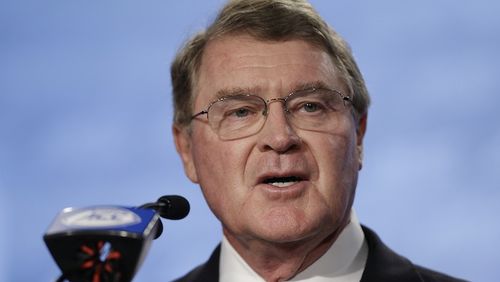If John Swofford’s memory is accurate, it was Oct. 8, 1966. The man who would one day become the ACC commissioner and one of the powerful figures in college athletics was a high-school senior from North Wilkesboro, N.C., a highly touted quarterback holding scholarship offers from across the SEC and ACC. And there he was, in the office of legendary Georgia Tech coach Bobby Dodd, just the two of them.
Outside of Dodd’s office, warm-ups had begun for the Tech-Tennessee game at Grant Field, a matchup of top-10 teams.
“I’ll never forget sitting there thinking, this man is sitting here talking to me and they’re warming up,” Swofford said in an interview with the AJC. “I couldn’t get over that.”
As high-school seniors put pen to paper to sign national letters of intent Wednesday, the story of a long ago recruit is worth telling. Tech fans – not to mention those from Swofford’s eventual alma mater, North Carolina – might be interested to know that Swofford seriously considered playing for the Yellow Jackets.
Swofford found himself in the thrall of Dodd, who at that point had established himself as one of the preeminent coaches of his era, known for winning eight consecutive bowl games, steadfastly graduating his players and a light touch on the practice field.
“I guess he and Bear Bryant were the Nick Saban and the Dabo Swinney of the era, in a sense,” he said.
Swofford returned for his official visit in December, where Dodd had another surprise for him. In a visit to a Tech practice as the Jackets prepared to play in the Orange Bowl, Dodd had Swofford join the offensive huddle.
“Kim King was the quarterback, and Kim had hosted me on my visit, and Lenny Snow was the tailback, and so I was very enamored with Georgia Tech and coach Dodd and how much the players loved playing for him,” Swofford said.
Dodd was doing, it would seem, what coaches still do today – find creative ways to communicate to a recruit that he's special and wanted. (Swofford was careful to note that his joining the huddle was permissible by NCAA rules then. It actually sounds a little bit like a ploy used by former Georgia coach Mark Richt when he was recruiting running back Isaiah Crowell in January 2011.)
“For a high-school kid – they’re going to get ready to go to Miami for the Orange Bowl – and I’m stepping in the huddle listening to Kim King call plays out at Rose Bowl Field – that was rather impressionable, too,” Swofford said.
Swofford recalled another ploy that doesn’t sound too dissimilar from today’s methods. After playing in a North Carolina-South Carolina all-star game after his season, he took an official visit to South Carolina shortly after, where a number of participants from the all-star game (the Shrine Bowl – “it was a big deal then and still is”) also were invited. Swofford said Gamecocks coaches were putting on the hard sell.
“A lot of us off those teams were at South Carolina, and there was a lot of pressure to sign then and commit,” Swofford said.
(Swofford said the letter of intent was only a few years into its existence. The more significant document was the institutional grant, he said.)
“It was sort of hard to get out of Columbia with all those guys signing and trying to get those of us who didn’t to sign,” he said.
Swofford said all eight ACC schools and most of the SEC schools were recruiting him. Alabama was the only school that told him that its interest in him was as a defensive back, not a quarterback. (Sounds like Justin Thomas.) With that, Swofford crossed Alabama and Bear Bryant off his list.
“I was one of those quarterbacks, as most quarterbacks are, that’s not what you want to hear,” Swofford said.
It was a different time in that the public interest in recruiting was nothing like it has become.
“There were people that would verbally commit: This is where I’m going,” he said. “I don’t know how many people actually listened to them at the time.”
Swofford said he was torn between Tech and North Carolina, which was a diametric opposite of Tech from a football standpoint. The Tar Heels dismissed coach Jim Hickey at the end of the 1966 season and hired Georgia assistant Bill Dooley, brother of Vince Dooley. The Tar Heels were rebuilding. But, Swofford said, he probably was leaning toward Tech.
Those familiar with the timeline of Dodd’s career might guess what happened next. In February 1967, during Swofford’s senior year at Wilkes Central High, Dodd retired from coaching. It made the decision much easier.
“Certainly I learned at an early age that coaching changes and transitions and so forth can make a big difference to recruits, either the plus side or the minus side,” he said.
Swofford went on to play two seasons at quarterback for the Tar Heels, missed a season with mononucleosis and moved to safety back for his senior season, when he helped the Tar Heels win the ACC title.
“So I guess the people at Alabama knew what they were doing,” Swofford said.
Swofford said he isn’t one to wonder what might have happened had Dodd stayed and he had chosen to attend Tech. His decision to enroll at North Carolina proved beneficial beyond measure. He has spent his entire professional career within the ACC, starting with a job in the Virginia athletic department and then returning to North Carolina, where he rose to become athletic director at 31 and moving from there to the commissionership in 1997. (After graduating from North Carolina, he earned a master’s in sports management from Ohio University. It was recommended to him by the UNC athletic director, Homer Rice, who later successfully filled the same position at Tech.)
Still, more than 50 years later, the memory of sharing a moment with Dodd during pregame warmups lingers.
“I was just amazed by it,” Swofford said. “Later on I figured out he probably did that with 10 other players.”
Likewise, his esteem for the coach remains.
“He had such a tremendous reputation as a player’s coach and went about things differently than a lot of coaches of that era in terms of how he practiced and how he treated players and so and so forth,” Swofford said. “That was extremely appealing to me.”







